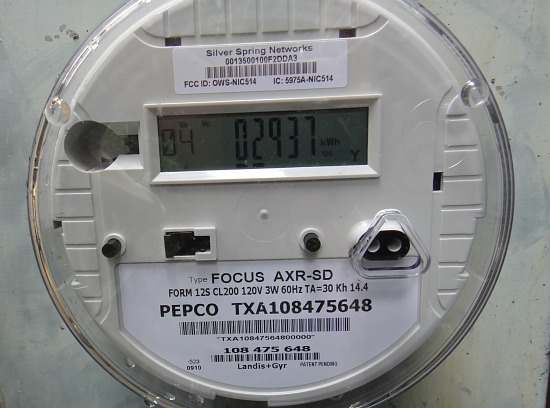What's Hot: Nearly $1 Million An Acre: Pricey Land Sale Near Dan Snyder's Alexandria Home Closes Out 2025
 Will New Smart Meters Bring an End to Huge Pepco Bills?
Will New Smart Meters Bring an End to Huge Pepco Bills?
✉️ Want to forward this article? Click here.

The new Smart Meter
Early last week, Pepco received some bad press, and it wasn’t about the utility company’s response to outages during the recent winter storms. Rather, a story from TBD featured interviews with a handful of customers complaining that their recent bills were extraordinarily high.
A day later, an UrbanTurf reader wrote in about his abnormally high January bill. He noted that this high bill seemed to coincide with the installation of new “smart” meters, which the utility company began installing across the city last October, and wondered if the new meter was the cause of the higher bill.
The exact cause of the higher bills is hard to pin down, as residents’ energy use varies widely on a case-by-case basis. UrbanTurf did some digging and asking around, and while it would be convenient to pin increases across the city on errors made by Pepco, it is likely due largely to higher energy costs and abnormally cold temperatures in January.
While it is frustrating not to come up with a simple answer for the high bills, the new smart meters will likely help residents better track and reduce their energy usage. Before getting into how the new meters will help in that regard, here is a brief tutorial of how Pepco costs break down.
About 72 percent of a Pepco bill goes to cover the cost of electricity, which is unregulated and subject to market forces. The price for transmitting the electricity and the maintenance of local energy infrastructure accounts for about 23 percent of a monthly bill. This cost is regulated by the District’s Public Service Commission, who last granted Pepco a rate increase in March 2010, adding around $2/month to standard residential bills. The remaining five percent of the bill goes to taxes and other surcharges.
As for energy usage, customers are currently charged a flat rate schedule based on each kilowatt hour of usage. For example, a 100-watt light bulb running for 10 hours — or one kilowatt hour (kwh) – should cost around 13 cents based on the winter schedule (summer rates are slightly higher). In contrast, a heat pump used four hours a day in a 1,000 square-foot apartment might consume around 1,100 kwh of electricity each month, costing the user about $143. And if your home uses a heat pump — a method that takes air from outside before warming it and bringing it inside — a drop of just a few degrees can lead to bill increases that are proportionally much higher.
“When the temperature gets down below 35 degrees, a heat pump is extremely inefficient,” said Betty Ann Kane, chairwoman of the PSC that regulates Pepco rates. “When it gets that low, a backup heater kicks in, and that can get very expensive.” Three times more expensive, easily, according to a local heating professional UrbanTurf consulted.
With that explanation, it shouldn’t be hard to understand that in the winter, costs for electricity go up as usage increases. DC residents with sharp memories might remember that back in February 2009, many residents noticed their bills increase and there was similar disbelief among area customers. But the winter weather was largely to blame as the average temperature dropped about 10 degrees between December 2008 and January 2009.
Regardless of the cause, the installation of the smart meters at residences in the city will hopefully help residents better track and manage their electricity usage. The new meters are essentially digital upgrades from the analog meters, and will eventually be able to track energy usage in real time, and send the information between customers’ homes and Pepco — so no more meter-readers coming around each month. They will be able to monitor not just how much energy is used, but when it is being used, and eventually customers will be able to check online and be able to view usage data from the day before. Smart-meter technology would also eliminate the need for estimated bills, a byproduct of the fact that sometimes meters are inaccessible to the meter-reader.
According to Pepco spokesman Bob Hainey, as of February 18th, approximately 27,000 of the new meters have been installed, or slightly more than 10 percent of the Pepco customer base in the District. While it is possible that homes with the new meters could have experienced higher bills in January, that would only be because the new meters give more accurate assessments of usage than those they replaced.
“It is very rare that we find a meter that is not charging accurately, and even rarer for the more advanced meters,” said Richard Morgan, a commissioner on the Public Service Commission. “Meters are usually undercharging, not overcharging.” Brian Golden, who runs the Virginia-based Smart Grid Group, agrees that the smart grids are usually correct: “These meters are accurate. As an industry, we’ve been measuring electricity uses for a very long time. If there are problems, it’s either in people’s understanding, or it could be a software issue.”
Additionally, the meters enable monitoring that could utilize a rate schedule that either charges based on what time of day electricity is being used or charges based on overall demand on the grid. The former example, a “time-of-use” schedule, would charge predetermined rates depending on the time of day. The latter option, known as “dynamic” pricing, would mean that using electricity when there is great demand – like during a heat wave – would cause everybody’s prices to spike.
“If the grid is stressed and all of your most expensive power plants are running, that means that everybody’s power is very expensive at that moment. One option is to charge higher prices during those times and effectively send a signal to customers that this is a time when the grid needs your help, and that you can save a whole lot of money by reducing your load,” Morgan explained.
It will ultimately be up to Pepco to make a proposal for a new rate schedule, and up to the PSC to approve it, which Kane said will take at least 18 months. “[Pepco] came in with a proposal that would keep the basic rate and give a rebate back to the customer if they reduced their use during certain peak times in the summer,” she told UrbanTurf. Richard Morgan, who oversaw a smart meter pilot program during 2008 and 2009, provided further details.
“The customer would be on the same rate schedule they were on before, but would have an opportunity to get a rebate if they reduce their load when there’s a peak event called. [For example,] if the company announced that four hours on a hot afternoon would be a peak event, anybody who reduces then might receive a rebate.”
That pilot program tested this rebate method, as well as the aforementioned time-of-use and dynamic pricing schedule. In practice, this saved money for customers who reduced their energy usage. “We had a limited number of hours where the price would multiply five-fold,” Morgan said. “If a customer has a typical load pattern, didn’t change their use at all, they would wind up with the exact same bill. On the other hand, if the customer really responds to the price signal, they could save quite a bit.”
Whichever rate system Pepco and the PSC decide on, the need for an aggressive consumer education campaign will be very important.
“Education is absolutely critical,” Golden, the smart-grid consultant, told UrbanTurf. “And that was be the biggest shortcoming of Pacific Gas and Electric.” Golden is referring to California’s Pacific Gas and Electric, which dealt with its own slew of grievances in 2009 when it installed smart meters. That fall, the state’s Public Utility Commission received 600 complaints that the new meters were overcharging for electric usage. A third-party review was conducted, and it was determined that the meters weren’t overcharging, but in fact increased usage due to high temperatures, compounded by higher energy prices, resulted in the high bills. The report also concluded that “customer skepticism regarding the new advanced meter technology was not effectively addressed by PG&E on a timely basis.”
The current complaints about Pepco and bills in DC seem to be mirroring the situation in California. Once the smart meters are installed here, will Pepco be able to get in front of such skepticism and convince District residents that the new technology isn’t a rip-off? They likely have their work cut out for them. A release from Councilmember Tommy Wells’ office said that the new system is expected to cost “in the vicinity of $90 million, $44.6 million of which Pepco has received a federal grant to cover. The balance will have to be collected from ratepayers through an increase to be determined by the Public Service Commission once the program is completely up and running.”
See other articles related to: editors choice, pepco, smart meters
This article originally published at http://dc.urbanturf.production.logicbrush.com/articles/blog/will_new_smart_meters_bring_an_end_to_huge_pepco_bills/3055.
Most Popular... This Week • Last 30 Days • Ever

Today, UrbanTurf offers a brief explanation of what it means to lock in an interest r... read »

The 30,000 square-foot home along the Potomac River sold at auction on Thursday night... read »

An application extending approval of Friendship Center, a 310-unit development along ... read »

A key approval could be coming for a proposal to convert a Georgetown office building... read »

Capital Bikeshare breaks a record; Trump potentially legalizes weed sales in DC; and ... read »
DC Real Estate Guides
Short guides to navigating the DC-area real estate market
We've collected all our helpful guides for buying, selling and renting in and around Washington, DC in one place. Start browsing below!
First-Timer Primers
Intro guides for first-time home buyers
Unique Spaces
Awesome and unusual real estate from across the DC Metro













